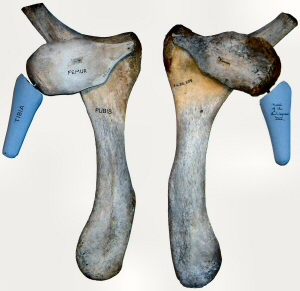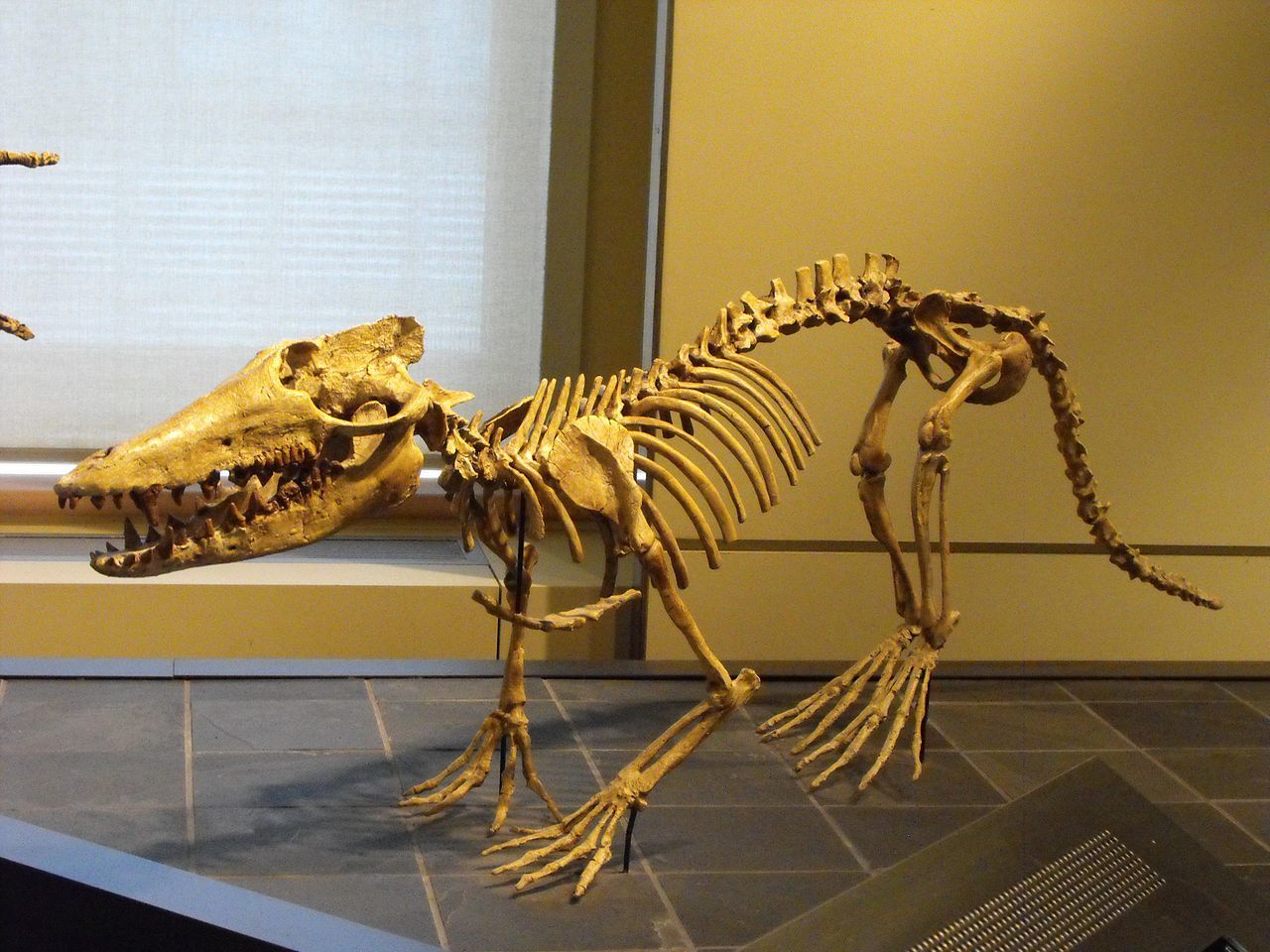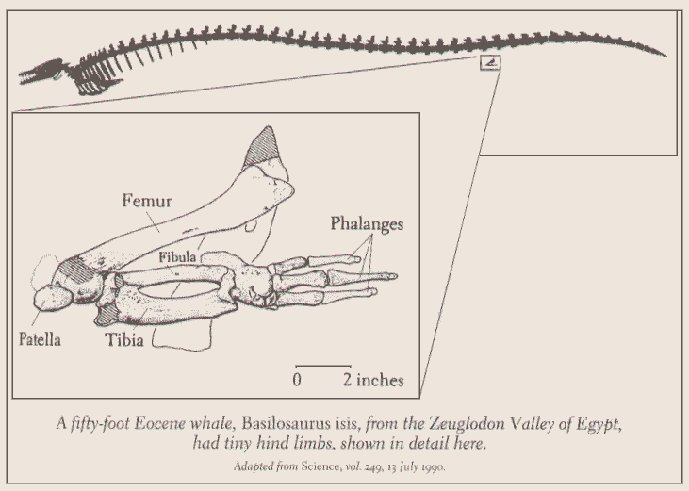So the question is back on: why would whales have vestigial, non-coding DNA for legs present in their genome?
the front limb look like hand. but its a complete fin. so even if its look like leg it isnt a leg.
You crack me up, D!
We aren’t talking about dolphins. And we aren’t talking about malformed fins.
We are talking about those modern whales which, without having ANY KIND of malformation at all … have LEG BONES within their body, which cannot be seen by ANYONE (except God).
And these leg bones are consistent with extinct varieties of whale mammals that actually HAD fully formed, or partly formed, legs (or shall we call them rear limbs.
George
hi again chris.
but wait. i show its wrong actually:
- take a look at this basilosaurus image (see how much it
s look like yours images):
https://designeranimals2011.wikispaces.com/Basilosaurus
" However, there had been numerous suggestions that these small hind “legs” were used to aid copulation by locking their long, narrow bodies"
now see this image:
even according to evolutionists those are flippers and not legs. as you can see from the restoration.
again- where is your reference?
hi dcs,
First, I note that you have not addressed my chief point, namely that the (rare) appearance of atavistic legs in some species of whales provides strong evidence for the continuing existence of unused genetic code for legs, which in turn provides strong evidence for evolution. I want to give you another opportunity to address that point.
[quote=“dcscccc, post:18, topic:4419”]
Chris: "Nothing can be imagined more useless to the animal than rudiments of hind legs entirely buried beneath the skin of a whale
dcs: but wait. i show its wrong actually:
[/quote]
You are very, very confused, my friend dcs. I’m talking about vestigial femurs and tibias, and then you present evidence for the usefulness of something else altogether, the pelvic girdle. Let me make it as clear as I can:
- You are correct that the structure of the pelvis continues to play a useful role in whale anatomy.
- You have not begun to address the strong evidence for evolution provided by vestigial femurs and tibias in some modern whales.
I am astonished that you would think that this supports your case, my friend dcs. The basilosaurus, which lived 40M years ago, was (perhaps) able to make use of the legs which were much smaller than those of its ancestors. Modern whales don’t have such legs, so the functionality of legs in a species that lived 40M years ago aren’t germane to today’s topic. You could go back even further, say 60M years, and state that the legs of the common ancestor of whales and hippos were very useful. Yep, I would agree–it lived on the land, and legs are useful on land. Doesn’t help your case.
Evolution has continued to operate over these past 40M years, and whatever function hind limbs might have provided to the basilosaurus was not enough to overcome the pressure of natural selection towards a more hydrodynamic design.
Endless Forms Most Beautiful by Sean Carroll, a biologist at the University of Wisconsin. Great book, you’d really enjoy it, dcs.
ok. chris. see this image (in the end) of the basilosaurus hind limbs:
http://palaeos.com/vertebrates/cetartiodactyla/basilosauridae.html
you can see that basilosaurus did have a femur and tibia. but it was a fin and not a leg. so the same for the whale.
What the ? @DCSCCC ?!
If you go back into the fossil whale record … you will see whales and proto-whales with all sorts of combinations of limbs … This is because mammals had 4 limbs… and it can sometimes take more than millions of years to genetically lose something you don’t need.
The point that was raised in this thread is that some MODERN WHALES have under-developed femurs that are completely buried in their tissues … so they don’t exist for swimming or mating or anything. They are just laying their dormant … because there was a time in whale gene pools when they NEEDED their rear limbs.
QUOTE 1:
The existence of a pair of small pelvic bones is known to exist in nearly all of the Cetacea, lying far apart from the vertebral column on both sides of the genital opening.
However, in the Fin Whale, the Blue Whale, and the Humpback, the femur too is present near the pelvis. [Even in the Sperm Whale the femur is sometimes present (in the form of a small round-shaped bone near the pelvis). - E.T.B.]
And in the Right Whale not only the femur but also the tibia exists. Of course these bones are buried deeply under the skin, causing no protuberance on the body surface."
[Quote from Ogawa, R., and Kamiya, T. A. (1957) “Case of the Cachalot [Sperm Whale] With Protruded Rudimentary Hind Limbs.” Scientific Reports of the Whales Research Insititute, No. 12, p. 197-208.]
QUOTE 2:
Hind Limb Rudiments on Modern Whales Example Five
HIND LIMB RUDIMENTS FOUND ON MODERN DAY WHALES
“Nothing can be imagined more useless to the animal than rudiments of hind legs entirely buried beneath the skin of a whale, so that one is inclined to suspect that these structures must admit of some other interpretation. Yet, approaching the inquiry with the most skeptical determination, one cannot help being convinced, as the dissection goes on, that these rudiments [in the Right Whale] really are femur and tibia.”
“The synovial capsule representing the knee-joint was too evident to be overlooked. An acetabular cartilage, synovial cavity, and head of femur, together represent the hip-joint. Attached to this femur is an apparatus of constant and strong ligaments, permitting and restraining movements in certain directions; and muscles are present, some passing to the femur from distant parts, some proceeding immediately from the pelvic bone to the femur, by which movements of the thigh-bone are performed; and these ligaments and muscles present abundant instances of exact and interesting adaptation. But the movements of the femur are extremely limited, and in two of these whales the hip-joint as firmly anchylosed, in one of them on one side, in the other on both sides, without trace of disease, showing that these movements may be dispensed with. The function point of view fails to account for the presence of a femur in addition to processes from the pelvic bone. Altogether, these hind legs in this whale present for contemplation a most interesting instance of those significant parts in an animal – rudimentary structures.” [Struthers, p. 142-143]
[Struthers, John, M.D., Professor of Anatomy in the University of Aberdeen. (1881) “On the Bones, Articulations, and Muscles of The Rudimentary Hind-Limb of the Greenland Right-Whale (Balaena mysticetus).”]
Hi dcs -
In spite of all the evidence of femur and tibia bones that I and George have cited and provided links for, you somehow seem to think that an artist’s depiction of basilosaurus should allow you to ignore that evidence. Really? I’m feeling discouraged, like maybe somehow I’m such a poor writer that I have failed to communicate clearly. Or is the communication failure on your side? Maybe you are too busy to consider our evidence? I would understand that, I am pretty busy at times, too. But if you are too busy to examine the evidence we cite, how is it that you have the time to respond in the thread? Or maybe you’re distracted by the vicissitudes of life? ???
Regardless, before you do anything else, please read the eyewitness observations of leg bones that I wrote about here. Please read the George’s evidence of vestigial, visually hidden whale leg bones here.
Have a blessed day.
Grace and peace,
Chris Falter
After a good night’s rest, my friend dcs, I think I’ve identified the source of confusion. You seem to be believe that paleontologists should build their analysis of morphology on the imaginative renditions of artists, rather than the actual fossil bones.
This is of course not how scientists do their work. Scientists analyze the fossils, not the art… Then artists have the task of imaginatively depicting the result. The art is useful for science learners, because (when it’s accurate) a picture is worth 1000 words.
In the case of the Basilosaurus artistic renditions you keep appealing to, it seems the artists have done a poor job of rendering the hind limbs. So let’s do a little scientific analysis here by comparing Basilosaurus hind limb fossils with predecessor fossils and then with the skeletons of modern right whale vestigial hind limb bones. We’ll array them from earliest to latest and see if Basilosaurus hind limbs are in an evolutionary sequence. We’ll start with the Pakicetus hind limbs as photographed by Kevin Guertin from Ottawa, Ontario, Canada - DSCF1201, CC BY-SA 2.0. Pakicetus lived 60 mya.
Now Basilosaurus (40 mya) from the same source that provided one of your artistic renditions:

For scale and clarity, here’s another basilosaurus image:
Now the modern right whale:

I should add that basilosaurus is not thought to be directly on the cetacean lineage; it seems like an evolutionary dead end. A late Eocene contemporary like dorudon is closer to the evolutionary lineage. But basilosaurus is close enough for us to draw the conclusion that it is part of the family tree that leads to modern whales.
dear chris and george.
your argument was that femur and tibia are evidence for leg. so i showed clearly that it isnt true and those structure can be seen in fins. case close.
not even according to evolutionary whale expert Philip Gingerich:
‘It seems to me that they could only have been some kind of sexual and reproductive clasper."
again- not legs but a part of the reproduction system. add to this the fact that in rare cases dolphins have an extra back fins in the same place of those “legs” and you will get the right picture.
@DCSCCC,
So let me get this straight … you are saying that modern whales that have an internal bone structure is NOT an evolutonary remnant from when these mammals had rear legs? And that …
you say that some Modern Whales RETAIN a hidden bone structure that is left over from evolution from whales who used to have a FIN in that location …
EITHER WAY, DCS, that’s evolution…this is the NORMAL state of these modern whales in question … this is not some rare aberration.
its not evolution but degeneration. the whale lost its back fins.
So you agree that modern whales have ancestors who possessed legs, but over time those legs were lost. Interesting. And exactly what George and I have been saying, by the way.
not legs but fins.
Case never opened. To have a case, or better yet a discussion, we both need to discuss the same evidence/data. But you have essentially spat upon the photographs/graphics that I labored long and hard to present.
Dolphins diverged from whales roughly 40 mya. Of course there are differences between them. Yet you seem, incredibly, to believe that everything about dolphins must somehow be identical to whale counterparts.
You refuse to examine evidence from whales, and instead draw conclusions about whales from their distant cousins, the dolphins. Would you conclude a man named Chris is a felon because his sixth cousin Engelbert once committed a murder? Or would you say that you need to look at the evidence specific to Chris? You need to start looking at the whale evidence. Repeating over and over that dolphin evidence tells you everything you need to know about whales, so you don’t need to look at actual whale skeletons, convinces no one.
So are you contending that fins are part of the reproduction system? You have been insisting that Basilosaurus hind limbs are actually fins. But now you’ve changed your tune, and called them part of the reproduction system.
I would also ask: do other species make use of their legs during sex? How about homo sapiens, for example?
In other words, dcs, the only way you can even attempt to construe Gingerich’s statement as proof that Basilosaurus hind limbs were not legs is to add on several other statements which are, to put it mildly, nonsense. And you arrive at a conclusion (part of the reproduction system) that contradicts yourself (fins), without even realizing it.
But here is more proof that Gingerich believed the Basilosaurus hind limbs were legs: he wrote an article entitled “Hind Limbs of Eocene Basilosaurus: Evidence of Feet in Whales,” Science 249, July 13, 1990, p. 154. Feet attach to legs, do they not?
EDIT: Fixed a typo
Yes, good catch.
DCS, really? You are going to argue that Whales are a DEGENERATE creature … rather than accept the reality of evolution? The fact that whales are perfectly designed to plunge deep into the ocean … and live a completely aquatic life (because of these degenerations) means nothing to you?
There’s really no point in discussing any of this further with you.
I think the next thing you will say is that apes are DEGENERATE DINOSAURS.
See yah, DCS!
You mean they aren’t DEGENERATE DINOSAURS?
lets be serius chris. i gave several evidence that dolphin never had legs but fins:
1)the fact that we found dolphin with extra back fins
2)the fact that we found a function for this inside structure
3)the fact that even in the suppose whale and dolphin ancestor we found that they may function as fins
4)the fact the front limbs of the whale made in similar way and still function as fins
i already link to an article that saying it may have several functions. we just dont know for sure.
i guess you miss this article:
https://news.usc.edu/68144/whale-reproduction-its-all-in-the-hips/
it may be my last response in this discussion.
This topic was automatically closed 6 days after the last reply. New replies are no longer allowed.


